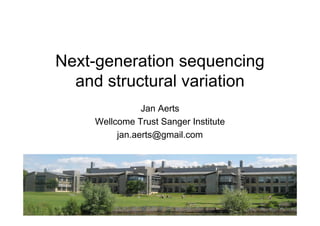
Next-generation sequencing reveals structural variation detection challenges
- 1. Next-generation sequencing and structural variation Jan Aerts Wellcome Trust Sanger Institute jan.aerts@gmail.com
- 2. principles & pittfalls vs list of commands
- 3. What is structural variation? • “variation that changes the structure of a chromosome” • Mechanisms: NAHR, NHEJ, FoSTeS • This presentation: focus on discovery (not: genotyping) “experiment 4” from last slide Thomas
- 4. Types of structural variation
- 5. Approaches for discovery Combination of: • Read pairs • Read depth • Split reads • Fine-mapping breakpoints: local assembly => Identify signatures
- 7. RP - General principle • Paired-end library => insert size • Orientation/distance
- 8. RP - Signatures Medvedev et al, 2009
- 9. RP - Real world
- 10. RP - Workflow overview Mapping Identify discordant readpairs Cluster on location Filter on nr RPs/cluster Filter on RD Filter: mappingQ x #readpairs Identify signatures Alternative reference Validate
- 11. RP - Mapping • Provides raw data => crucial • MAQ/bwa – only report one hit (mappingQ = 0) – MAQ might prefer mismatches to aberrant distance! • Insert size = distribution instead of exact
- 12. RP - Discordant readpairs • Orientation • Distance – Plot insert size distribution for chromosome – Very long tail! => difficult to set cutoff: • 4mad or 0.01%?
- 18. RP - Clustering “standard clustering strategy” – Only consider mate pairs that do not have concordant mappings – Ignore read pairs that have more than one good mapping Clustering: use insert size distribution (e.g. 2x4 mad)
- 19. RP - Clustering: issues • Ignores pairs that have >1 good mapping => no detection within repetitive regions (segmental duplications) • What cutoff for what is considered abnormal distance? (4 mad? 0.01%? 2stdev?) • Low library quality or mix of libraries => multiple peaks in size distribution
- 20. RP - Filtering • On nr RPs/cluster – Normally: n=2 – For high coverage (e.g. pilot 2: 80X): n=5 • On drop in RD & SR • On (mappingQ x nrRP) – If published data available: ROC for different cutoffs mQxnrRP – If not: very difficult
- 21. RP - Issues • Difficult => different groups = different results “consensus set” – RP & SP: many set agree – RD: totally different • CEU (80X): sometimes drop in RD in all 3, but RP spanning only in 2 => why?? • Mapper = critical; maq/bwa: only 1 mapping (=> many false negatives); mosaik, mrFAST: return more results
- 22. RP - Issues (2) • Large insert size: low resolution for detecting breakpoints • Small insert size: low resolution for detecting complex regions
- 23. B. Read Depth
- 24. RD - General principle • Similar to aCGH: using reference RD file (e.g. based on 1kG) • In theory: higher resolution, but noisier than aCGH – Algorithms not mature yet – More complex steps => Data binned
- 25. RD - Exome here: using exome data
- 26. RD - Example
- 27. RD - Workflow overview • Mapping • Read filtering • GC correction • Spike identification • Validation
- 29. RD - mapping Critical… (see RP)
- 30. RD - Filtering • mapQ – mapQ >= 0 (noisy; few FN, many FP) – mapQ >= 10 – mapQ >= 30 (many FN, few FP) • Mean depth exon (often: e.g. +/- 0.01) – Mean depth > 1 – Mean depth > 5
- 31. RD - Filtering: what’s left mapQ >= 0 mapQ >= 10 mapQ >= 30 all 207,000 207,000 207,000 mean DP exon > 1 169,000 163,000 162,000 mean DP exon > 5 160,000 153,000 152,000
- 32. RD - correction • Mainly: GC – Other: repeat-rich regions, mapping Q, … • Fit linear model GC-content exon and RD of exon => noise decreases
- 35. RD - segmentation • Identify spikes • Many segmentational algorithms, e.g. GADA • Issues: setting parameters: when to cut off peaks? – Combine outputs from different runs with different parameters – Compare to known CNVs
- 36. RD - Combine algorithms
- 39. RD - Issues • How to assess TP/FP/FN? => compare with known CNVs • Breakpoints: unknown – 1 datapoint/exon – Can be outside of exon • Different parameters for rare vs common CNVs => which?
- 40. C. Split Reads
- 41. SR - Principle
- 42. SR - Mapping Short subsequences => many possible mappings Solution: “anchored split mapping” (e.g. Pindel)
- 44. D. Local reassembly Aim: to determine breakpoints Which reads? – for deletions: local reads – for insertions: hanging reads for read pairs with only one read mapped – (rather not: unmapped reads) For large region: split up
- 47. Conclusions • Available algorithms: more to demonstrate technique rather than complete solution • Different algorithms => different results
- 48. Chris Yoon
- 50. Genotyping • Create alternative reference => remap reads – All reads vs reads covering variant locis – Whole-genome vs concatenation of variant loci • Homozygous insertions/deletions: should disappear • Heterozygous insertions/deletions: should have different signatures • Bayesian approach: see what’s the most likely: do the reads support wild-type/het/homnonref? • Not exact mapping => local reassembly – Microhomologies & non-template sequence => “breakpoint” = region of 2-10 bp • Convention: left-most position reported (but not always)
- 51. References and software • Medvedev P et al. Nat Methods 6(11):S13-S20 (2009) • Lee S et al. Bioinformatics 24:i59-i67 (2008) • Hormozdiari F et al. Genome Res 19:1270-1278 (2009) • Campbell P et al. Nat Genet 40:722-729 (2008) • Ye K et al. Bioinformatics 25(21):2865-2871 (2009) • Chen K et al. Genome Res 19:1527-1541 (2009) • Yoon S et al. Genome Res 19:1586-1592 (2009) • Du J et al. PLoS Comp Biol 5(7):e1000432 (2009) • Aerts J & Tyler-Smith C. In: Encyclopedia of Life Sciences (2009)
- 52. Questions?
